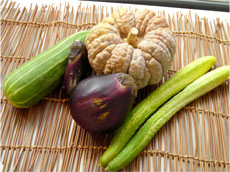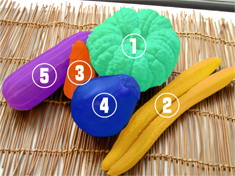|
|
|
 |
 Inspired by a successful promotion of Kyo-yasai (specialty vegetables from Kyoto), branding and marketing locally-grown traditional vegetables has become a recent national trend. In Osaka, growers and community leaders have been working together to establish Naniwa-yasai brands and have been promoting Tennoji kabura (turnip), Kema kyuri (cucumber), Kotsuma nankin (pumpkin), Suita kuwai (arrowhead), Senshu tamanegi (onion), Tanabe daikon (radish) and such, all of which have their own unique shape, taste and texture. Inspired by a successful promotion of Kyo-yasai (specialty vegetables from Kyoto), branding and marketing locally-grown traditional vegetables has become a recent national trend. In Osaka, growers and community leaders have been working together to establish Naniwa-yasai brands and have been promoting Tennoji kabura (turnip), Kema kyuri (cucumber), Kotsuma nankin (pumpkin), Suita kuwai (arrowhead), Senshu tamanegi (onion), Tanabe daikon (radish) and such, all of which have their own unique shape, taste and texture. |
 |
| Shuzo Ueno is one of the leading figures
who has been working hard to rediscover and re-establish the market
for Naniwa-yasai, whose production had significantly declined during
the nation's postwar period of economic growth. Ueno, a food writer
and a former owner chef of renowned Japanese restaurants, has studied
a vast amount of old documents and visited many fields and farms
throughout Osaka in search of these specialty vegetables that had
almost been forgotten, even among the locals. He talked to the
growers, learned the characteristics of each variety, and used
them in his own recipes to introduce them to the local food industry,
other farmers, wholesalers, and academics. |
 |
| While the efforts of Ueno and other
promoters successfully brought a variety of Naniwa vegetables back
to the market, several production issues also became evident, such
as that they were difficult to grow and were more labor intensive,
that they were costly and less competitive at the market, and that
many were older generation producers and often had difficulty in
finding successors. To support the producers of Naniwa-yasai, Ueno
formed a group and started developing a system to encourage the
distribution of Naniwa vegetables, mainly as cooking ingredients
to be used at a variety of restaurants from Japanese to French
and Italian. The group grew as participating members reached nearly
200. Its activities were later taken over and have been continued
until today by a NPO named Naniwa Gyosai-no Kai (President: Yoshitaka
Sasai). Local governments, both Osaka Prefecture and Osaka City,
have also began taking part of the promotion of Naniwa-yasai brands
by establishing a certification program, networking retailers,
and supporting the development of new products made from Naniwa
vegetables. |
 |
The promotion of rare traditional vegetables also
contributes to the preservation of true species that have been
uniquely grown in the community.
Today, common varieties marketed for consumers are mostly F1 hybrid,
an improved version of species that rapidly became popular in the
1960's because of their superior disease/pest resistance, productivity,
and appearance (colors and shapes). The mass productivity helped
reduce the production cost, which attracted many farmers. The number
of producers who still grow costly traditional varieties is significantly
limited today. A successful marketing of the traditional species
therefore will determine whether we are able to preserve delicious,
safe-to-eat vegetables that were provided by nature exclusively
to certain areas and regions. |
 |
Traditional varieties of vegetables
are attracting more attention today in the wake of the recent
slow food movement. Branding local agricultural products has
also become a nationwide trend. It all started in the late 1970's
in Kyoto when both the Prefecture and the City began a project
to support producers of Kyo-yasai. Established in 1989,
the official certification program of Kyo-yasai now
targets 21 varieties of traditional vegetables originating in
Kyoto, including Kujo negi (green onion), Shogoin
daikon (radish), and Kamo nasu (eggplant). Today,
many communities throughout the country have successfully promoted
their own brands of specialty vegetables, such as Kaga yasai (vegetables
from Kanazawa), Naruto kintoki (sweet potato from Tokushima),
and Hakata banno negi (green onion from Fukuoka), just
to name a few.
Today's branding strategy of agricultural products
by local communities does not merely focus on promoting the name
recognition of their products but is designed as a comprehensive
project that aims to revitalize the entire community, including
the improvement of food safety and the protection of intellectual
properties. Promoting local brands of traditional vegetables
simply means protecting the local food tradition and culture.
The promoters of Naniwa-yasai are expected to continue
improving the production/distribution issues and to advance the
branding project to a higher stage by reflecting the wider, more
diverse needs. |

[1] Kotsuma nankin
Originates in the Tamade District, Nishinari-ku, Osaka-shi
(former Kotsuma Village). A small-sized pumpkin which fits
in both of one's hands when cupped together.
[2] Kema kyuri
Originates in Kema-cho, Miyakojima-ku, Osaka-shi. White fleshed
cucumber with small dark bumps on its skin. Can grow to over 30
centimeters in length. Two thirds of the body from the top is pale
green/white in color. The skin is crunchy and the flesh is tender,
juicy, and flavorful. The top part is bitter.
[3] Baba nasu
Grown in the Baba District, Kaizuka-shi. The original eggplant
of a variety called mizunasu. It has thin and tender skin
while the flesh tastes less bitter and has a rich flavor.
[4] Torigai nasu
Grown in the Torigai District, Settsu-shi. A round shaped eggplant
with delicately tender skin. Flesh is dense and stays firm when
cooked.
[5] Tamatsukuri Kuromon Shirouri
Grown near Tamatsukuri, the gate of Osaka Castle during the Edo
period. Its large and long body of this cucumber-like vegetable
has a deep green skin marked with white stripes. Mainly produced
for pickling purposes today.
|
■"Naniwa Yasai Kappo Shinan (How
to Cook Naniwa Vegetables)"
by Shuzo Ueno, Create Kansai,
2007)
The book is full of Ueno's essays, "Naniwa Shunsai Aji-Goyomi," a series featured in the community food magazine, "Amakara Techo." The first book is exclusively dedicated to Naniwa-yasai (vegetables). In the book, Ueno visits vegetable farmers throughout Osaka in search of Naniwa vegetables, introduces 37 varieties he discovered, and shares with readers 128 original recipes he created with his sophisticated cooking techniques.
◇Shuzo Ueno
Born in 1935 in Osaka, Ueno started his culinary career at age 15 and opened his own restaurant, "Naniwa Kappo Kigawa," in 1977 in the Hozenji Yokocho District, Osaka-shi. In 1994, Ueno opened another restaurant, "Tenjinzaka Ueno," which he closed in 2003 despite strong requests from his customers to stay open. Today, Ueno continues his career as a food essayist/writer. He is also a member of Naniwa Gyosai-no Kai.
■Related links
Naniwa Gyosai-no Kai (President: Yoshitaka Sasai)
The group aims to bring quality fresh produce that traditionally originated in Osaka back to the market and promote the recognition of these once-lost local specialties. The group holds food tasting events and seminars, sells Naniwa vegetables, and publishes "Ukamuse," a magazine that specializes in local food culture.
URL:http://www.ukamuse.jp/
(only available in Japanese) |
October 3, 2007
Hiroshi Yamanou, Osaka Brand Center
|
|
|
